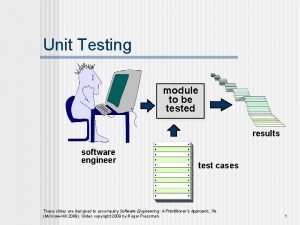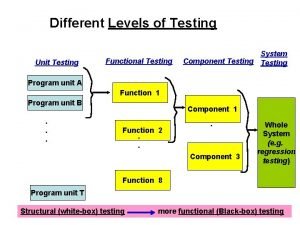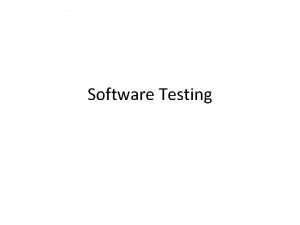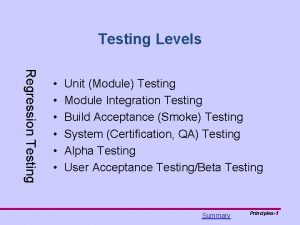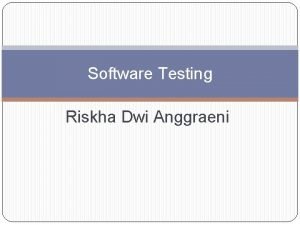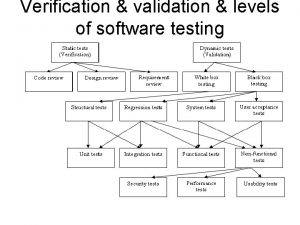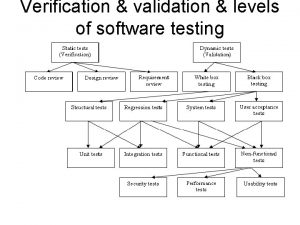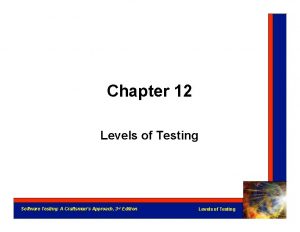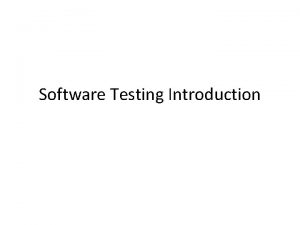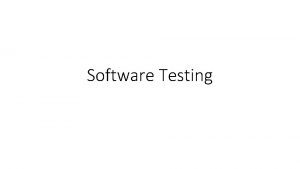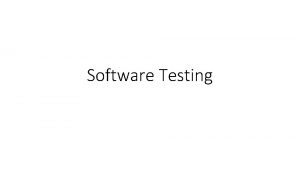Software Testing Levels of Testing o Unit Testing
























- Slides: 24

Software Testing

Levels of Testing o Unit Testing o Integration Testing o Validation Testing n Regression Testing n Alpha Testing n Beta Testing o Acceptance Testing


Unit Testing o Algorithms and logic o Data structures (global and local) o Interfaces o Independent paths o Boundary conditions o Error handling

Why Integration Testing Is Necessary o One module can have an adverse effect on another o Subfunctions, when combined, may not produce the desired major function o Individually acceptable imprecision in calculations may be magnified to unacceptable levels

Why Integration Testing Is Necessary (cont’d) o Interfacing errors not detected in unit testing may appear o Timing problems (in real-time systems) are not detectable by unit testing o Resource contention problems are not detectable by unit testing

Top-Down Integration The main control module is used as a driver, and stubs are substituted for all modules directly subordinate to the main module. 2. Depending on the integration approach selected (depth or breadth first), subordinate stubs are replaced by modules one at a time. 1.

Top-Down Integration (cont’d) Tests are run as each individual module is integrated. 4. On the successful completion of a set of tests, another stub is replaced with a real module 5. Regression testing is performed to ensure that errors have not developed as result of integrating new modules 3.

Problems with Top-Down Integration o Many times, calculations are performed in the modules at the bottom of the hierarchy o Stubs typically do not pass data up to the higher modules o Delaying testing until lower-level modules are ready usually results in integrating many modules at the same time rather than one at a time o Developing stubs that can pass data up is almost as much work as developing the actual module

Bottom-Up Integration o Integration begins with the lowest-level modules, which are combined into clusters, or builds, that perform a specific software subfunction o Drivers (control programs developed as stubs) are written to coordinate test case input and output o The cluster is tested o Drivers are removed and clusters are combined moving upward in the program structure

Problems with Bottom-Up Integration o The whole program does not exist until the last module is integrated o Timing and resource contention problems are not found until late in the process

Validation Testing o Determine if the software meets all of the requirements defined in the SRS o Having written requirements is essential o Regression testing is performed to determine if the software still meets all of its requirements in light of changes and modifications to the software o Regression testing involves selectively repeating existing validation tests, not developing new tests

Alpha and Beta Testing o It’s best to provide customers with an outline of the things that you would like them to focus on and specific test scenarios for them to execute. o Provide with customers who are actively involved with a commitment to fix defects that they discover.

Acceptance Testing o Similar to validation testing except that customers are present or directly involved. o Usually the tests are developed by the customer

Test Methods o White box or glass box testing o Black box testing o Top-down and bottom-up for performing incremental integration o ALAC (Act-like-a-customer)

Test Types o Functional tests o Algorithmic tests o Positive tests o Negative tests o Usability tests o Boundary tests o Startup/shutdown tests o Platform tests o Load/stress tests








 Level 1 thinking answers the question
Level 1 thinking answers the question What is domain
What is domain Motivational overview of logic based testing
Motivational overview of logic based testing Du path testing
Du path testing Globalization testing in software testing
Globalization testing in software testing Cause effect graphing technique
Cause effect graphing technique Control structure testing in software engineering
Control structure testing in software engineering Decision table testing in software testing
Decision table testing in software testing Decision table for triangle problem
Decision table for triangle problem Decision table testing is white box
Decision table testing is white box Rigorous testing in software testing
Rigorous testing in software testing Testing blindness in software testing
Testing blindness in software testing Domain testing example
Domain testing example Functional testing vs unit testing
Functional testing vs unit testing What is unit testing in software
What is unit testing in software Embedded software unit testing
Embedded software unit testing Unit 6 review questions
Unit 6 review questions Different levels of testing
Different levels of testing Testing levels
Testing levels Cmm levels in software project management
Cmm levels in software project management Unit 1 levels of organization
Unit 1 levels of organization Positive testing vs negative testing
Positive testing vs negative testing Cs 3250
Cs 3250 Makalah black box testing
Makalah black box testing Black-box testing disebut juga sebagai behavioral testing
Black-box testing disebut juga sebagai behavioral testing














